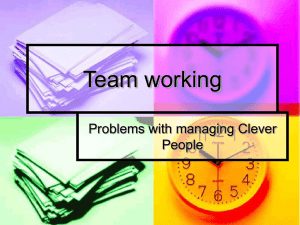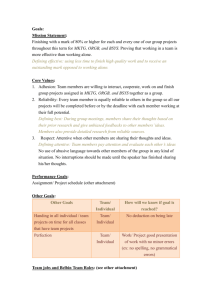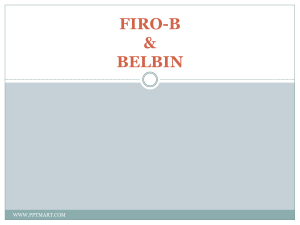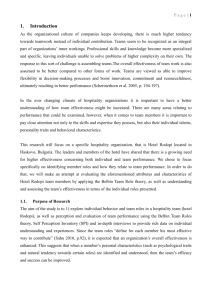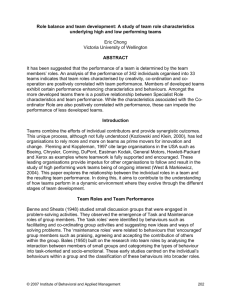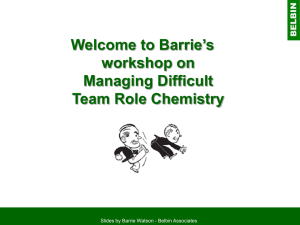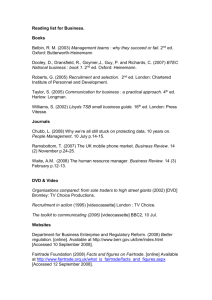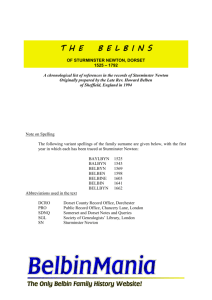Belbin Team Roles: Understanding Team Dynamics & Performance
advertisement
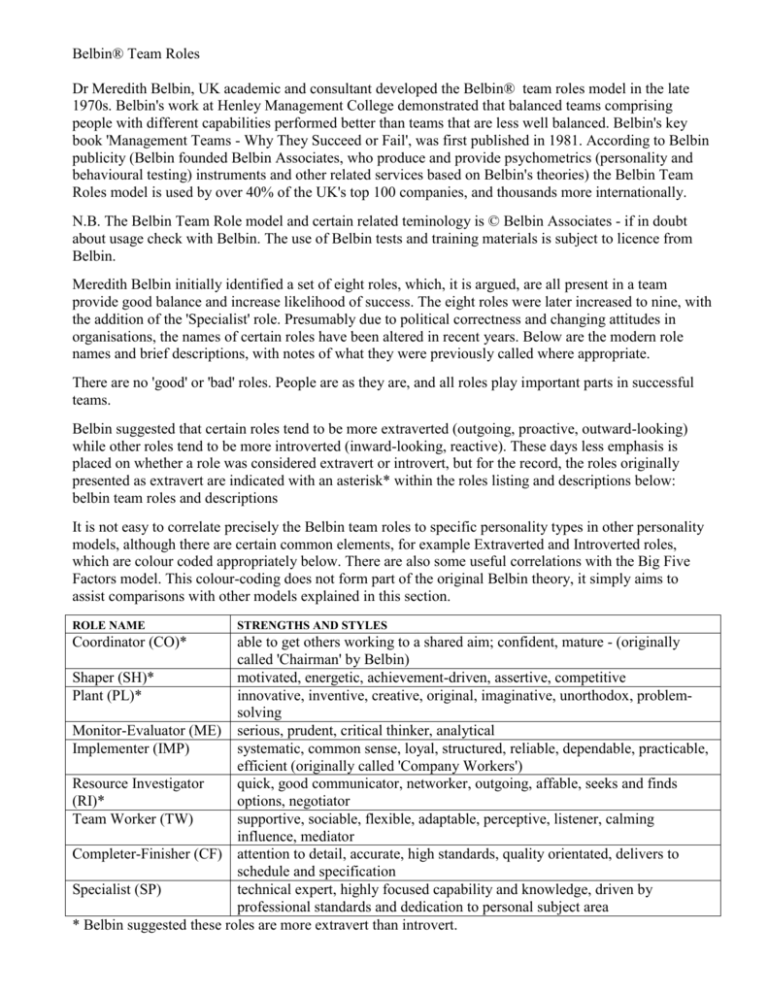
Belbin® Team Roles Dr Meredith Belbin, UK academic and consultant developed the Belbin® team roles model in the late 1970s. Belbin's work at Henley Management College demonstrated that balanced teams comprising people with different capabilities performed better than teams that are less well balanced. Belbin's key book 'Management Teams - Why They Succeed or Fail', was first published in 1981. According to Belbin publicity (Belbin founded Belbin Associates, who produce and provide psychometrics (personality and behavioural testing) instruments and other related services based on Belbin's theories) the Belbin Team Roles model is used by over 40% of the UK's top 100 companies, and thousands more internationally. N.B. The Belbin Team Role model and certain related teminology is © Belbin Associates - if in doubt about usage check with Belbin. The use of Belbin tests and training materials is subject to licence from Belbin. Meredith Belbin initially identified a set of eight roles, which, it is argued, are all present in a team provide good balance and increase likelihood of success. The eight roles were later increased to nine, with the addition of the 'Specialist' role. Presumably due to political correctness and changing attitudes in organisations, the names of certain roles have been altered in recent years. Below are the modern role names and brief descriptions, with notes of what they were previously called where appropriate. There are no 'good' or 'bad' roles. People are as they are, and all roles play important parts in successful teams. Belbin suggested that certain roles tend to be more extraverted (outgoing, proactive, outward-looking) while other roles tend to be more introverted (inward-looking, reactive). These days less emphasis is placed on whether a role was considered extravert or introvert, but for the record, the roles originally presented as extravert are indicated with an asterisk* within the roles listing and descriptions below: belbin team roles and descriptions It is not easy to correlate precisely the Belbin team roles to specific personality types in other personality models, although there are certain common elements, for example Extraverted and Introverted roles, which are colour coded appropriately below. There are also some useful correlations with the Big Five Factors model. This colour-coding does not form part of the original Belbin theory, it simply aims to assist comparisons with other models explained in this section. ROLE NAME Coordinator (CO)* STRENGTHS AND STYLES able to get others working to a shared aim; confident, mature - (originally called 'Chairman' by Belbin) Shaper (SH)* motivated, energetic, achievement-driven, assertive, competitive Plant (PL)* innovative, inventive, creative, original, imaginative, unorthodox, problemsolving Monitor-Evaluator (ME) serious, prudent, critical thinker, analytical Implementer (IMP) systematic, common sense, loyal, structured, reliable, dependable, practicable, efficient (originally called 'Company Workers') Resource Investigator quick, good communicator, networker, outgoing, affable, seeks and finds (RI)* options, negotiator Team Worker (TW) supportive, sociable, flexible, adaptable, perceptive, listener, calming influence, mediator Completer-Finisher (CF) attention to detail, accurate, high standards, quality orientated, delivers to schedule and specification Specialist (SP) technical expert, highly focused capability and knowledge, driven by professional standards and dedication to personal subject area * Belbin suggested these roles are more extravert than introvert. N.B. It does not follow that extraverted roles are always self-motivating. Neither does it follow that introverted roles need 'motivating' or instructing. The proactivity, direction, attitude and motivation of any roles, in a Belbin context (as for any other personality profiling system), depend on a wide variety of factors, including alignment of organisational and personal aims and values, personal circumstances, emotional maturity, life-stage, leadership influences, reward systems, and more. Greater understanding of these issues can be achieved by considering many different behavioural perspectives, theories and models. The simplest central point relating to motivation is that different people respond to different stimuli. Therefore the more we understand about ourselves and people, then the more we understand about what motivates us. People are more motivated and happy when they are performing and working in a way that is natural to them. Expecting a person with a particular personality type (be it represented by a Belbin team role, a Jung psychological type, a Myers Briggs® MBTI®, or whatever) to perform well and enthusiastically in a role that is foreign or alien to their natural preferences and strengths is not helpful for anyone. The UK DTI quality management guidance notes provides further some useful interpretation of the parts that these roles play in teams: 'Belbin team roles' within teams The Coordinator clarifies group objectives, sets the agenda, establishes priorities, selects problems, sums up and is decisive, but does not dominate discussions. The Shaper gives shape to the team effort, looking for pattern in discussions and practical considerations regarding the feasibility of the project. Can steamroller the team, but gets results. The Plant is the source of original ideas, suggestions and proposals that are usually original and radical. The Monitor-Evaluator contributes a measured and dispassionate analysis and, through objectivity, stops the team committing itself to a misguided task. The Implementer turns decisions and strategies into defined and manageable tasks, sorting out objectives and pursuing them logically. The Resource Investigator goes outside the team to bring in ideas, information and developments to it. They are the team's sales-person, diplomat, liaison officer and explorer. The Team Worker operates against division and disruption in the team, like cement, particularly in times of stress and pressure. The Finisher maintains a permanent sense of urgency with relentless follow-through. All of these roles have value and are missed when not in a team; there are no stars or extras. An individual's team role can be determined by the completion of a Belbin questionnaire. It is not essential that teams comprise eight people each fulfilling one of the roles above, but that people who are aware and capable of carrying out these roles should be present. In small teams, people can, and do, assume more than one role. In addition, analysing existing teams and their performance or behaviour, using these team role concepts, can lead to improvements, for example: Under-achievement demands a good coordinator or finisher Conflict requires a team worker or strong coordinator Mediocre performance needs a resource investigator, innovator or shaper Error prone teams need an evaluator Different roles are important in different circumstances, for example: New teams need a strong shaper to get started. Competitive situations demand an innovator with good ideas. In areas of high risk, a good evaluator may be needed. Teams should, therefore, be analysed both in terms of what team roles members can play, and also in relation to what team skills are most needed. Despite having well defined roles within a team, the interaction between the different personalities of individuals can be a frequent source of friction. However, this can largely be avoided by understanding and valuing people's differences. (The above notes about Belbin team roles within teams are UK DTI quality management guidance notes and are Crown Copyright.) Source: http://www.businessballs.com/personalitystylesmodels.htm#belbin%20team%20roles%20descriptions
